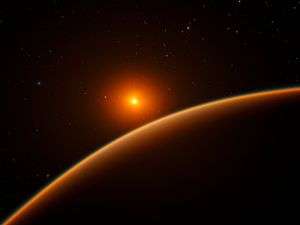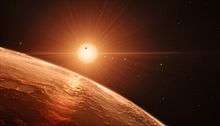LHS 1140 b
| Exoplanet | List of exoplanets | |
|---|---|---|
 | ||
| Parent star | ||
| Star | LHS 1140 | |
| Constellation | Cetus | |
| Right ascension | (α) | 00h 44m 59.31s |
| Declination | (δ) | −15° 16′ 16.7″ |
| Apparent magnitude | (mV) | 14.18 |
| Distance | 40.67 ± 1.37 ly (12.47 ± 0.42 pc) | |
| Spectral type | M4.5V | |
| Mass | (m) | 0.146 (± 0.009) M☉ |
| Radius | (r) | 0.186 (± 0.013) R☉ |
| Temperature | (T) | 3131 (± 100) K |
| Metallicity | [Fe/H] | -0.24 (± 0.10) |
| Age | >5 Gyr | |
| Physical characteristics | ||
| Mass | (m) | 6.65 (± 1.82) M⊕ |
| Radius | (r) | 1.43 (± 0.10) R⊕ |
| Stellar flux | (F⊙) | 0.41 ⊕ |
| Density | (ρ) | 12.5 ± 3.4 g cm−3 |
| Surface gravity | (g) | 3.25 (± 1.54) g |
| Temperature | (T) | 230 K (−43 °C; −46 °F) |
| Orbital elements | ||
| Semi-major axis | (a) | 0.0875 (± 0.0041) AU |
| Eccentricity | (e) | <0.29 |
| Orbital period | (P) | 24.73712 (± 0.00025) d |
| Inclination | (i) | 89.912 (± 0.071)° |
| Discovery information | ||
| Discovery date | 20 April 2017 (Published) | |
| Discoverer(s) | MEarth | |
| Discovery method | Transit | |
| Discovery status | Confirmed | |
LHS 1140 b is a massive, dense rocky planet orbiting within the conservative habitable zone of the red dwarf LHS 1140. Discovered in 2017 by the MEarth Project, LHS 1140 b is nearly 7 times the mass of Earth and over 40% larger in radius, putting it within the Super-Earth category of planets. It is one of the densest planets found, with a density over twice that of Earth, along with a high surface gravity of about 3.25g. LHS 1140 b orbits entirely within the star's habitable zone and gets 41% the incident flux of Earth. The planet is only 40 light-years away and transits its star, making it an excellent candidate for atmospheric studies with ground-based and/or space telescopes.[1]
Characteristics
Mass and Radius
LHS 1140 b was detected using both the radial velocity method (which measures the mass of a companion object) and transit photometry (which determines radius). Because of this, LHS 1140 b is one of very few potentially habitable exoplanets with a determined mass and radius, the others all being those around TRAPPIST-1. The planet's radius is well-constrained at 1.43±0.10 R⊕, equivalent to about 9,110 km. It is one of the smallest radius values for any potentially habitable planet and similar to that of Kepler-62f. Using the HARPS (High Accuracy Radial velocity Planet Searcher) spectrograph on the ESO 3.6m telescope at La Silla Observatory in Chile, the discovery team was able to determine the mass of LHS 1140 b, and found that it is around 6.65 M⊕, with an uncertainty parameter of ±1.82 M⊕. If it were to have an Earth-like composition, the mass of the planet would instead be closer to 3 M⊕. The density of LHS 1140 b comes out to be around 12.5 g/cm3, one of the highest ever observed for a rocky planet and over twice the density of Earth. This gives it a surface gravity of 3.25 times that of Earth, even higher than that of Jupiter. To escape the gravity of LHS 1140 b, a craft would have to move at 24 km/s, or nearly 54,000 mph. LHS 1140 b's incredibly high density suggests an iron-rich composition, with an iron-nickle core taking up to 75% of the planet's total mass.[2] For comparison, Earth's core comprises about 17% of its mass, over four times less than LHS 1140 b.
Orbit and Temperature
The orbit of LHS 1140 b takes 24.737 days to complete, much quicker than Earth's year of 365 days. Its orbital radius is at 0.0875 AU, or 8.75% the distance between Earth and the Sun. While this is quite close, the star LHS 1140 is so dim that the planet only get 0.41 times the incident flux of Earth at this distance. With an albedo of 0, LHS 1140 b has an equilibrium temperature of 230 K (−43 °C; −46 °F), compared to Earth's at 255 K (−18 °C; −1 °F). If LHS 1140 b has an albedo similar to that of Earth, the equilibrium temperature would be even lower, at 201 K (−72 °C; −98 °F). However, with a greenhouse effect at least as strong as Earth's LHS 1140 b would have a surface temperature greater than 266 K (−7 °C; 19 °F) for an albedo of 0. Due to the high mass of the planet, it likely has a thicker atmosphere with a more powerful greenhouse effect. In addition, the orbit of LHS 1140 b is rather eccentric. The discovery team found that a circular orbit is impossible due to tidal forces from the star, and that the planet's eccentricity is less than 0.29 with a 90% confidence. This would cause significant temperature variations as the planet swings closer and farther from its star over its 24-day orbit.[3]
Host Star
LHS 1140 b orbits a very small red dwarf, LHS 1140. It is a mere 0.146 times the mass and 0.186 times the radius of the Sun with a spectral type of M4.5V. The temperature of LHS 1140 is 3131°K, and it has a luminosity of 0.002981 LS. It is at least 5 billion years old. For comparison, the Sun is 1 solar mass and radius, has a temperature of 5,778°K with 1 solar luminosity, is 4.5 billion years old, and has the spectral type of G2V. In addition, LHS 1140 is a very inactive star, with no major flare events found by the discovery team of its planet. Unlike most stars its size, LHS 1140 has low amounts of activity and rotates every 130 days.[4]
Habitability
LHS 1140 b orbits close to the outer edge of the habitable zone, a region around a star where temperatures are just right for liquid water to pool on the surface of orbiting planets, given sufficient atmospheric pressure. The equilibrium temperature of LHS 1140 b is rather low, at 230 K (−43 °C; −46 °F), as cold as the polar regions on Earth. However, this is the calculated temperature excluding the impact of a thick atmosphere. With an Earth-like greenhouse effect, the surface temperature is about 266 K (−7 °C; 19 °F), but since the planet is so massive, the greenhouse effect may be even higher. At twice the GE of Earth, LHS 1140 b would have a comfortable surface temperature of 296 K (23 °C; 73 °F). In addition, the host star is so inactive that atmospheric erosion will not be very high, which would allow the planet to warm up.[5]
See also
- Nearby potentially habitable exoplanets
- K2-3d, the densest and most massive rocky habitable zone planet
- Kepler-1652b, a potentially habitable "Mega-Earth"
- Habitability of red dwarf systems
- List of potentially habitable exoplanets

